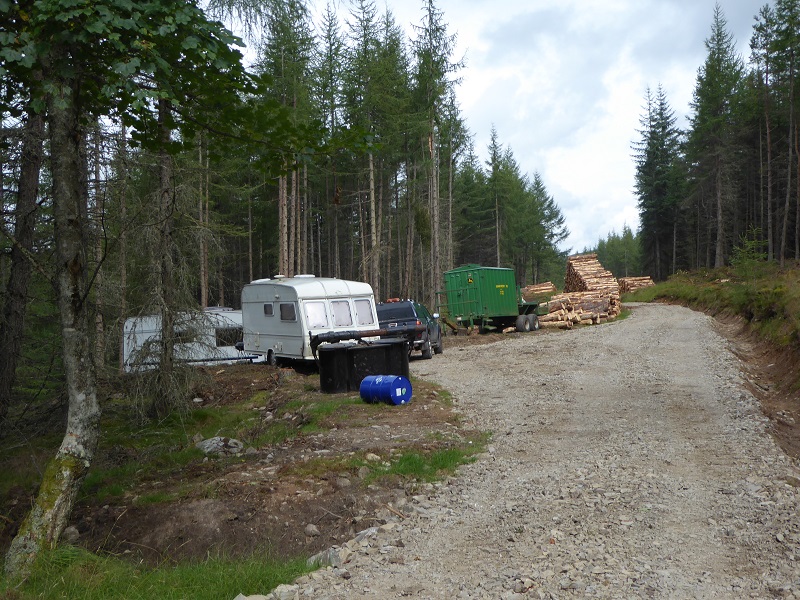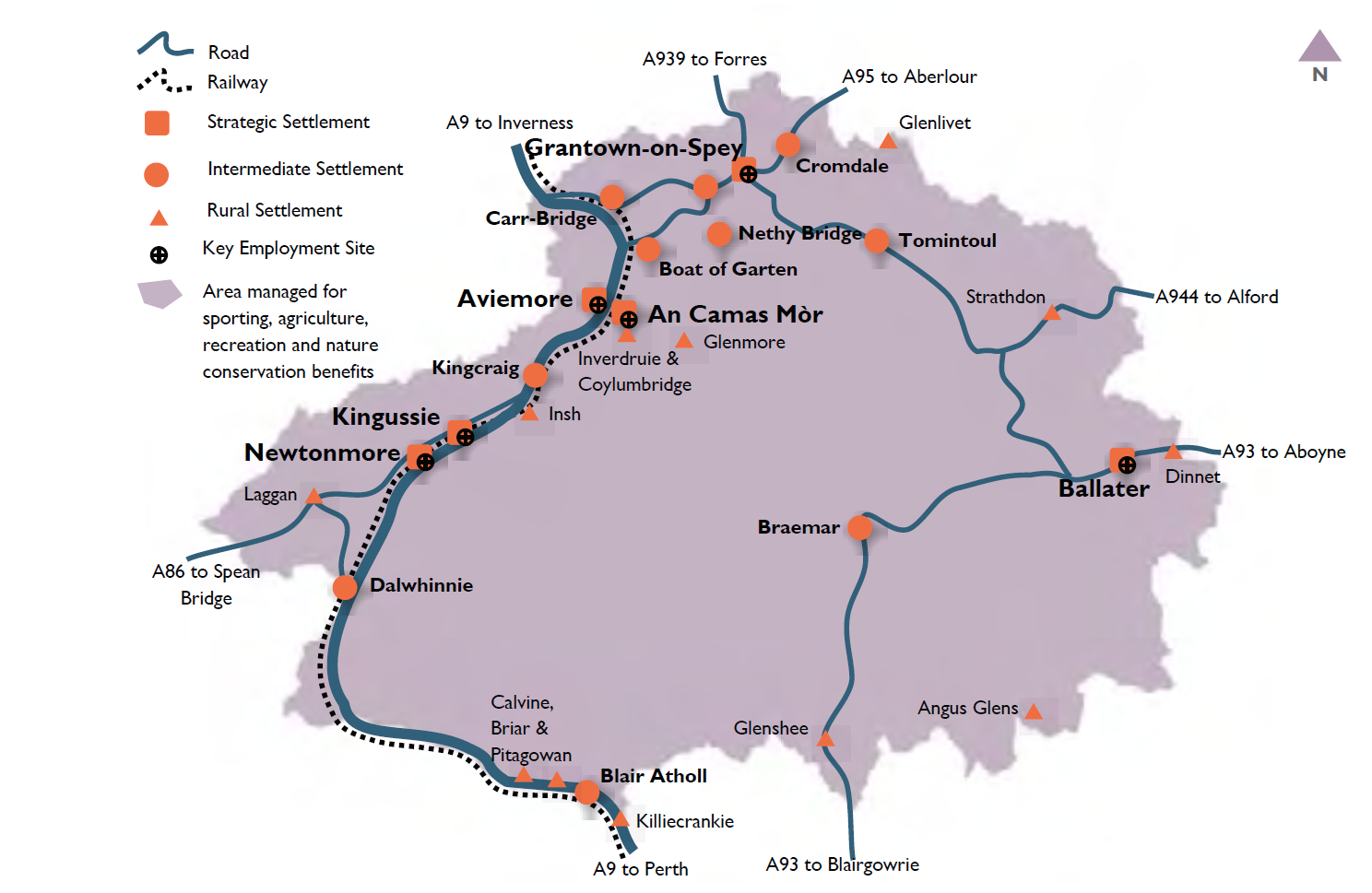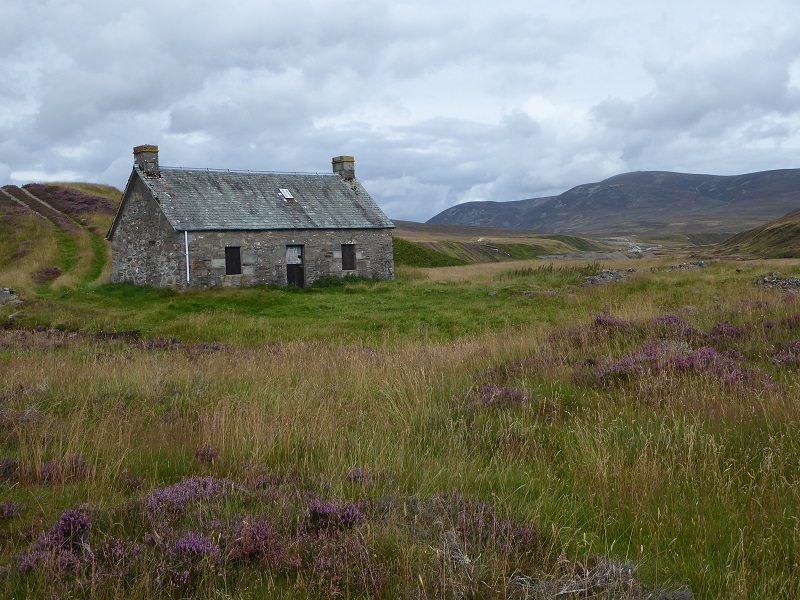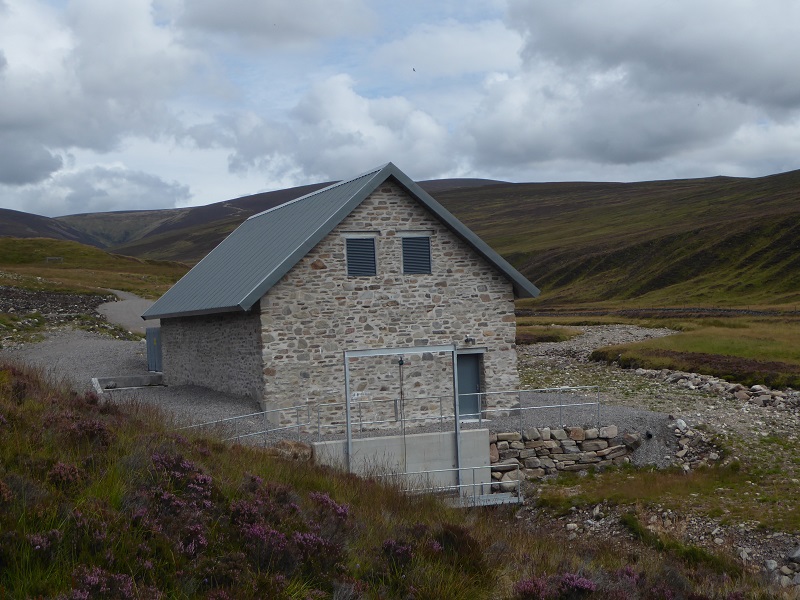
The consultation on the Cairngorms Main Issues Report (see here), the discussion document which precedes the new development plan, closes this Friday. The Scottish Government has mooted in the Planning Bill the abolition of such reports with Planning Authorities moving direct the draft plan stage in the name of efficiency. To their credit, the Cairngorms National Park Authority has raised concerns about this, the argument being its better to consider issues at a high level before getting into specifics. I agree, although the big challenge for the planning system it to get people and organisations to respond to consultations and draft plans which help determine where developments take place rather than waiting till planning applications appear and then objecting to these. For that to happen, people will need to feel that contributing to plans makes a difference.
The reality is though that the public have little room to influence this with most development in the National Park being, rightly or wrongly, driven by Scottish Government decisions. This gives the CNPA relatively little room to maneuver or to suggest alternatives on matters such as the A9 upgrade and targets for new housing.
Where should development happen in future?

The most important question in the Main Issues Report is the first, “where should development happen in future?” The Park’s strategy on this, and whole thrust of the development plan, is to direct development, particularly those driven by the Scottish Government, to the main settlements. Outside of these areas the CNPA states that conservation and public enjoyment should come first.
Now, I have a lot of sympathy for this: National Parks should be putting landscapes, wild land and wildlife first and need to banish any idea that major developments in our mountains or areas important for conservation would be appropriate. We need to remember proposals from the past, before the National Park was created, such as those ls to build a road through the Lairig Ghru and to develop Lurchers Gully for downhill skiing. Given half an opportunity, developers would take it – as can be seen only too clearly with the current proposals to redevelop the Ptarmigan at the top of Cairngorm.
Having said this, however, I believe that the CNPA’s reasoning behind this policy is flawed:
“There are clear opportunities for growth and development within and around the existing settlements of the Park, both to maintain their status and to provide the new homes, businesses and other facilities that are needed to ensure their future sustainability.”
Commentary: why is development needed to ‘maintain the status’ of existing settlements and ensure their future sustainability? The reasoning appears based on the idea that unless settlements grow they will collapse. If accepted, this will just store up pressure for settlements to expand their boundaries in future. Settlements such as Aviemore, whose water supply was creaking last year and which is surrounded by woodlands important for wildlife, are big enough already. Whatever happened to small is beautiful?
“However, most of the land outside the Park’s main settlements is farmland, moorland, forestry, woodland and mountain that is valued for nature,recreation, and land management activities. There is relatively little development here, and while some future development may be needed to support ongoing land management activities, the lack of development and the sense of wildness is one of the key characteristics which needs to be maintained in these areas.”
Commentary: the claim that land outwith the main settlements is valued for its “land management activities” is even more flawed when sporting estates are the dominant form of land-use. Grouse moor management and deer present the main challenge to the CNPA’s aspiration to promote nature conservation at the landscape scale. Sporting estates have also resulted in increasing rural depopulation as the number of keepers/stalkers has been reduced. Look at the bottom right corner of the map above, and you can see the problem – most of the Angus Glens are a grouse moor desert.
“The existing Local Development Plan therefore outlines an overall development strategy which focuses most development to the main settlements in the National Park – Aviemore, Ballater, Grantown-on-Spey, Kingussie and Newtonmore – along with a proposed new settlement at An Camas Mòr. These settlements are referred to as ‘strategic settlements’. The strategy also allows for some development in other ‘intermediate’ and ‘rural’ settlements in order to meet local needs, as well as permitting small-scale development which adds to existing groups of buildings in rural areas. Outside of these areas, the development strategy is more restrictive and aims to support the use of land for nature conservation, forestry/woodland expansion, agriculture, and recreation benefits.”
The assumption underpinning this appears to be that people living in remote areas are somehow incompatible with conservation. Historically, this is rubbish. When more people lived in the glens, the wildlife there was much richer and it was the creation of sporting estates which cleared both people and wildlife from much of the area and still does. I am not advocating that we should repopulate the mountain core, but I am suggesting the CNPA should take another look at where it allows new housing and economic development to take place.
An unnecessarily restrictive approach to housing
The CNPA development proposal map (above) indicates that there could be a real danger to ribbon development in Badenoch and Strathspey, from Newtonmore to Grantown, particularly with the dualling of the A9. This area was historically far less depopulated than other areas of the National Park and I can understand why the CNPA is proposing a restrictive approach to new housing in the countryside here.
However, there are other areas in the National Park, the Angus Glens for example but also the area around Laggan ,which in my view could support a higher permanent rural population and some more holiday accommodation. The CNPA is in danger of creating a vicious circle in terms of management of land owned by sporting estates: much of the limited housing available is tied housing linked to game keeping jobs and because of this no other forms of land-use are possible. In many places there is NO local community who could take over the land as happened at Laggan.
Moreover, to enjoy areas such as the Angus Glens, people need to have somewhere to stay. Without accommodation – not just housing but campsites – most people are limited to day visits. Conversely, as long as development is focussed around Aviemore and it provides the largest concentration of accommodation, recreational pressures in Glenmore will continue to increase. This creates another vicious circle where demand for accommodation feeds development pressures.
While the Main Issues Report does contain some tentative proposals to change this – stating that An Camas Mor may not be needed to meet housing targets and proposing some new houses in places like Dalwhinnie – development is still totally skewed to Aviemore. There is no real attempt to explore the potential of places like Dalwhinnie or Laggan let alone the more isolated places in the eastern half of the National Park..
I therefore believe the new Development Plan could allow some new housing in remote rural areas (if well designed and situated). It could also encourage former housing, which landed estates have allowed to become derelict, to be restored.


Unsustainable economic development
The need for housing is very much linked to the potential to use land in our National Parks differently – land-use is what the planning system in its widest sense should be about. If, for example, the CNPA is to fulfil its vision of landscape scale restoration, outside of the areas where natural processes should be allowed to predominate (and these should be big!), new types of land based job will be required. Reforesting Scotland has produced lots of possible examples for woodland over the years but for these ideas to happen people wanting to work on the land need to have places both to live and to work.
Under Main Issue 6, however, the CNPA recommends a change of policy on commercial and industrial sites from deciding these on a case by case basis, to allocating specific sites WITHIN settlements. This appears to exclude the possibility of the sort of small scale land-based economic operations that are common in other mountain areas – sawmills being an obvious example.
“Although it remains difficult to establish precise requirements for new economic development land, we think there is a case for allocating a limited number of additional sites in appropriate locations
– particularly where these would be located close to good transport links and existing centres of population. We have identified potential scope for new economic development land at Aviemore,
Carr-Bridge, Dalwhinnie, Dinnet and Kincraig.As identified previously in Main Issue 3 (p20),
a number of these sites will also help to take advantage of the potential for new inward
investment resulting from the dualling of the A9.”
It appears that economic development in the National Park is being determined by transport infrastructure, decided by the Scottish Government, and not by land-use. This creates a complete mismatch with the outcomes set out in the National Park Partnership Plan which all concern wider land-use and which CNPA suggests should also be the vision for the Local Development Plan:
• Conservation – a special place for people and nature with natural and cultural heritage enhanced
• Visitor experience – people enjoying the Park through outstanding visitor and learning experiences
• Rural development – a sustainable economy supporting thriving businesses and communities
The place of conservation in the National Park
The weakest section of the Main Issues Report, however, is Section 7 titled the “Impact on Natura designations”. This starts well “The Cairngorms National Park is a particularly important place for nature conservation” but then immediately reduces conservation to the question of how to protect Natura Sites (Special Protection Areas for Birds and Special Areas of Conservation) and then reduces that in turn to the protection of just two species, capercaillie and fresh water pearl mussel.
The Main Issues Report contains not a mention of other types of designated site – from Sites of Special Scientific Interest to Ramsar sites for wetlands – do they not face issues too? And there is no discussion of the impacts of developments on areas outwith the woodland inhabited by capercaillie and rivers inhabited by the fresh water pearl mussel. While hill tracks are dealt with under Main Issue 10, Land Management in Upland Areas, that chapter is all about landscape character and not about conservation. Hill tracks are an issue for both, as is demonstrated by the unlawful hill track at the head of Glen Banchor (see here) and I believe this section should have considered all the development pressures on nature conservation and not just housing.
The focus on capercaillie and the need to mitigate any developments which affect woodland appears driven by the potential impact of An Camas Mor:
“We think the new Local Development Plan should support delivery of the Cairngorms Capercaillie Framework. In particular, we think the new Plan should include a revised and more co-ordinated approach to capercaillie mitigation and conservation measures on a landscape scale. We could
do this by designing packages of measures to address the cumulative impacts of new development proposals around areas which are most sensitive for capercaillie and support the growth of good capercaillie habitat in the locations where it will have least disturbance from people. This would help us deliver the new development that our communities need and support the long term future of capercaillie populations”
This is far from clear but what the CNPA appears to be asking is whether people think access restrictions should be allowed to enable developments such as ACM to go ahead? If so, the answer to that should be NO!.
The CNPA has created a huge pickle for itself by concentrating its development proposals in the centre of capercaillie country. It would do far better to develop a policy presumption against any housing in woodland important for wildlife and relax its opposition to any development outwith settlements elsewhere. .
What needs to change for the new Local Development Plan
While the Main Issues report generally appears well intentioned, the CNPA needs to be braver about what National Parks should stand for. I would like to see the CNPA:
- Abandon its assumption that people living in the countryside are incompatible with nature conservation or the protection of our landscapes and recognise that if land-use, outside core areas of wild land, is to change, then more rural accommodation and workplaces will be required.
- Conversely take a firmer stand against yet more development in and around Aviemore in particular and considering how tourist infrastructure could be better distributed through the National Park.
- Reinforce the welcome message that development is NOT appropriate in some areas but at the same time allow some development to be dispersed by adopting an explicit countryside zoning policy: in the core zone there should be NO development but in the periphery outside of settlements occasional development could be permitted.
- Consequently develop policies setting out when developments in these peripheral areas might be appropriate.

Why are “land based jobs” the only driver for economic development in a highly rural area? Just do a web search for “creation of new technology infrastructure in the countryside” and you’ll see a wealth of reports on why doing this stimulates economic development that is NOT “land related”. This land plan reads like a blast from the pre-Internet era. If you think rather about where people would like to live, and what infrastructure they’d need to work from that location in a range of jobs from telecommuting to home-run businesses, then planning around “strategic settlements” sounds very dated. Of course the justification might be that its more costly to provide a full scope of public services to people who live less densely – but is that a basis for public planning (to motivate people only to live in ever bigger conurbations)?
Alternatively try searching for “the role of technology in rural development” and you’ll see lots of studies examining this in, say, India. But why can’t that same thinking be applied to rural Scotland (aka The Highlands)? You could describe failing to support rural communities by omission in this way as a form of clearance. considering the outcome it then drives.
So what should CNPA do? Try a more complete web search like “role of technology in rural development in the highlands” and read those academic and Scottish Enterprise research findings and case studies that have been produced over the years. Lots (and I mean lots) of creative approaches to sustainable rural development that have nothing to do with “traditional” land-based jobs creation and that could be applied to many settlements that now appear destined to appear “non strategic” and that will wither and die.
Andrew, thanks very much, this is thought provoking and an angle I completely missed. It was me, not the CNPA, who was arguing we should think about how the land could support more jobs and I still think that is right BUT of course there are other options for creating different types of job in rural areas and IT is a really good example. I agree with your argument that this does not need to be concentrated on certain strategic settlements and argument is very relevant to places such as Strathfillan, where local community have supported the goldmine for want of anything else. Nick
Again an excellent thought provoking article and I concur with Andrew’s comments. Encouragement of ‘new technology’ jobs can very usefully complement land based jobs.
I only managed to read this article on 2 March after completing my comments on the Main Issues Report. My comments to CNPA concur with much if not most of what you say in this article, Nick. I too think that the LDP should focus less on developments within the larger settlements and try to encourage selective well designed small developments in and around the smaller settlements.
I also agree that Section 7 titled the “Impact on Natura designations” is poorly written and far too restrictive in vision. This section should have been the major section, fully comprehensive and the one that drove and influenced the rest of the Report. Unfortunately, as usual, the conservation aim of the Park takes a back row seat. Also when will CNPA recognise re-wilding as a key issue in the Park?
My concern is – is CNPA listening or trying too hard to please our Scottish Government?